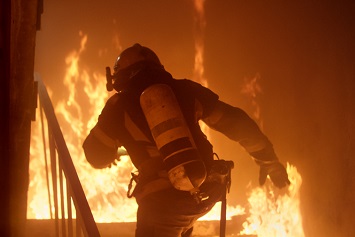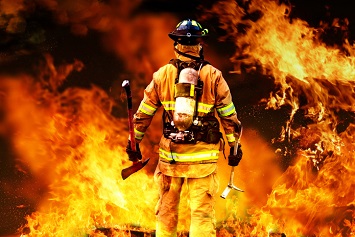According CareerCast’s 2018 annual survey of the most stressful occupations, firefighting ranks second only to working in the military. The survey found support in an October 2017 report by two researchers with the Health Hazard Evaluation Program (HHEP) of the National Institute for Occupational Safety and Health (NIOSH), who examined many occupational stresses firefighters experienced at one unnamed fire department. The report makes recommendations regarding mental health, training, and vaccinations. While the recommendations are specific to the fire department investigated, they can be applied in all fire departments.
Under the Occupational Safety and Health (OSH) Act of 1970, federal OSHA is prohibited from issuing standards to protect employees of state and local governments, a category in which firefighters generally fall. OSHA does have a fire brigade standard (29 CFR 1910.156), which covers industrial fire departments and private or contractual-type fire departments. State-plan states, however, are required to cover public sector (state and local government) workers, including firefighters.
Job Trauma
Walking into a burning building may seem like the most stressful part of a firefighter’s job. But in addition to actually fighting fires, the HHEP investigators listed 18 “traumatic events” firefighters said they experienced, including the fear of being killed or hurt by another person, seeing someone die in front of them, seeing injured or dead children, and witnessing a mass casualty event. These events can lead to post-traumatic stress disorder (PTSD).
Firefighters are first responders who frequently must contend with emergencies in addition to or apart from fires. One objective of the HHEP report was to determine the degree to which the community’s firefighters were confronted with hazards associated with drugs and drug overdoses. In a questionnaire filled out anonymously by 55 of the community’s 88 full-time firefighters, all 55 of the respondents said they had been traumatized by two events—responding to an emergency involving an opioid overdose and responding to more than one opioid overdose in a single shift. No other event received a “perfect” score.
While the community is not named, the HHEP investigators indicated that this particular community may be experiencing an above-average drug problem. Interactions between firefighters and drug users is growing nationwide. Regarding this particular fire department, the investigators stated:
“This fire department is located in one of five states with the highest rates of death from drug overdose. Over the 5-year period from 2011 to 2016, the total number of responses by this fire department each year increased from approximately 3,500 to 4,500, a 22 percent increase. During the same period, the number of medical-related fire department responses increased 65 percent, from approximately 1,300 to 2,200 each year. In the summer of 2016, the fire department responded to a mass overdose event involving 26 people at the same location over several hours.”
Key Findings
Key findings of the investigation include the following:
- On a job-stress scale of 0 (as low as it can be) to 10 (as high as it can be), the average score was 8.7. One firefighter indicated low job stress, three indicated moderate job stress, and 50 indicated high job stress.
- Fifty-three firefighters were screened for symptoms of PTSD. Of these, 7 (13 percent) screened positive for possible PTSD. Firefighters who had been physically attacked on the job had a significantly higher prevalence of positive PTSD screenings. No other types of traumatic events were associated with a positive PTSD screen.
- Two firefighters (4 percent) reported having suicidal ideation. Since the questionnaire was anonymous, the investigators could not directly intervene with these individuals to ensure they received mental health care. “However, we immediately alerted the fire chief about the suicidal ideation responses and provided the fire chief with local and national resources for suicide prevention and mental health,” said the investigators.
- Of the 53 firefighters who completed the items necessary to screen for symptoms of generalized anxiety disorder, 25 (47 percent) screened negative, 15 (28 percent) met the screening criterion for mild anxiety, 11 (21 percent) met the screening criterion for moderate anxiety, and 2 (4 percent) met the screening criterion for severe anxiety. Firefighters who had been in a situation on the job where they believed they would be killed by another person had a significantly higher prevalence of positive anxiety screenings.
- Of 54 firefighters, 23 (43 percent) reported that they would “somewhat” or “very much” like to receive training at work to help them cope with stress; 46 (85 percent) indicated they were “somewhat satisfied” or “very satisfied” with the amount of social support they receive from coworkers; and 27 (50 percent) reported they were “somewhat satisfied” or “very satisfied” with the amount of social support they receive from their supervisor(s).
- Most of the firefighters did not perceive stigma associated with receiving mental health care, but only 61 percent disagreed with the statement that receiving care would be “too embarrassing.” The greatest barriers to seeking mental health care was cost of services and skepticism about whether treatment would be effective.
- Forty-one firefighters (91 percent) reported receiving the three-part hepatitis B vaccine series; 2 (4 percent), who reported having worked at the fire department for more than 2 months reported not being offered the hepatitis B vaccine and were not vaccinated against hepatitis B.
- All interviewed firefighters reported always wearing gloves when attending to an individual who is “down” or “unconscious.” All 32 firefighters who reported handling needles or other sharps in the past 12 months reported wearing gloves when doing so.
- Having received training ranged from 27 percent for “what to do if there are drugs seen on-site” to 69 percent for “ways to reduce exposure to bloodborne pathogens on the job.”
- Two-thirds of the firefighters reported handling used needles or sharps within the past 12 months—13 (29 percent) reported handling them every shift, 9 (20 percent) every week, 6 (13 percent) every month, and 2 (4 percent) several times.
- Seven (16 percent) firefighters reported some type of potential bloodborne pathogen exposure during the past 12 months. Most of the potential exposures involved blood, vomitus, or urine coming into contact with gear or skin that was not covered. No reported exposure involved a needlestick.
- Nineteen firefighters (42 percent) reported coming into contact with drugs as part of their job duties in the past 12 months. One firefighter reported that the number of times this occurred was too numerous to count. The others reported a median of 11 times (range: 1 to 75 times). In general, firefighters described moving drugs or drug paraphernalia with drug residue away from the patient with gloved hands to perform job duties.
Conclusions
The researchers concluded that firefighting is an inherently stressful occupation where exposure to death and other traumatic events is very likely, making firefighters more prone to PTSD and other negative mental health outcomes than the general public. Firefighters are also faced with psychosocial stressors, such as limited resources, being understaffed, and concerns about job security, pay, and benefits. Job demands “greatly outweigh” the resources available.
Most firefighters interviewed indicated they would seek assistance if they had a mental health concern (e.g., from a religious leader or an employee assistance program). However, more than half said they would not see a mental health therapist; stigma was less a reason here than cost.
Few firefighters reported experiencing bloodborne exposure incidents. However, two-thirds reported handling used needles within the past 12 months, a risk factor for transmission. A slightly higher percentage reported administering naloxone with an auto-injector, which has a retractable needle. Because rates of HIV infection and viral hepatitis are substantially higher among persons who use drugs illicitly than among persons who do not, used needles might be more likely to be contaminated by bodily fluids with bloodborne pathogens. Less than half the interviewed firefighters with potential bloodborne exposures stated that they reported such incidents to the fire department.
Recommendations
Based on their findings, the investigators made the following recommendations to the fire department.
- Encourage employees to seek help from a qualified health professional if they are experiencing symptoms of depression, anxiety, PTSD, or other mental health disorders.
- Arrange for a mental health professional to give all firefighters an annual training or educational presentation about suicide prevention, psychological first aid, and recognizing signs of stress.
- Inform firefighters of the various mental health resources available to them.
- Provide training upon hire and at least annually thereafter on topics related to opioids, naloxone administration, and bloodborne pathogens. Periodically review training needs.
- Encourage employees to report all potential bloodborne pathogen exposure incidents, health effects from being in contact with drugs, and injuries caused by individuals immediately after they receive naloxone.
- Ensure that the hepatitis B vaccination is made available to all firefighters within 10 working days of initial assignment unless the firefighter has previously received the complete hepatitis B vaccination series, antibody testing shows immunity, or the vaccine is contraindicated for medical reasons.
- Include all the required elements of the exposure control plan according to the OSHA bloodborne pathogens standard (29 CFR 1910.1030) as a best practice.
- Provide nitrile gloves for firefighters to wear as a precaution against bloodborne pathogen exposure, as well as during opioid overdose response activities. Do not use latex gloves because of potential allergic reactions.


